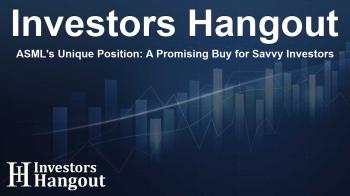ASML's Unique Position: A Promising Buy for Savvy Investors

ASML: A Valuable Player in the Tech Sector
In today's technology landscape, few companies have the kind of near monopoly that ASML Holding (NASDAQ: ASML) exhibits in the market. For smart investors, understanding these dynamics can lead to substantial profits, especially with the booming interest in artificial intelligence.
ASML is not just a stock to consider; it represents a functional stronghold in the production of chips and semiconductors, particularly in the niche of extreme ultraviolet (EUV) lithography equipment necessary for the latest chip technology. This business model places ASML in a favorable position as one of the few suppliers able to meet the demands of leading tech companies.
As the demand for cutting-edge technology increases, especially in sectors like artificial intelligence and advanced computing, ASML's services have never been more crucial. The reliance of major players such as NVIDIA and Intel on ASML's lithography technology underscores its essential role in the market.
Why Consider ASML for Your Investment Portfolio?
Investing in ASML can be a strategic move in navigating the complexities of the current market. Despite its pivotal role in the semiconductor industry, ASML finds itself underappreciated largely because of market sentiment and external factors, particularly regarding its exposure to Asian markets.
The current market environment has seen ASML's share price decrease significantly, trading at around 76% of its 52-week highs. Such undervaluation creates a noteworthy opportunity for patient investors who are willing to look beyond current fears and focus on long-term fundamentals.
Market Sentiment and Its Impact on ASML Valuation
Investor sentiment plays a crucial role in ASML's current valuation scenario. The perceived risks associated with its exposure to China have contributed to a broader reluctance to engage with the stock. However, this presents an opportunity for astute buyers. The contrast between ASML's historical price-to-earnings (P/E) ratio and current valuations is striking. Today, the forward P/E ratio stands at approximately 27.8x, which is considerably lower than its average historical multiple of about 40.0x.
This discrepancy could indicate a significant upside potential as investors slowly begin to recognize the company’s value, especially as they are drawn back to fundamentals. Past trends have shown that when major institutional investors start to recognize value, a trust base can quickly build, leading normal investors to follow suit.
Understanding ASML's Premium Valuation
Alongside its discounted P/E ratio, ASML also exhibits a 14.6x price-to-book (P/B) ratio, highlighting how investors are beginning to notice its potential even amidst fears regarding its market exposure. This P/B ratio not only presents a premium compared to the broader sector, where average valuations hover around 9.1x, but it also indicates that savvy insiders are recognizing the value offered by ASML.
For those able to withstand market fluctuations and the stigma currently associated with the company due to its ties with China, the potential for remarkable returns exists. In the upcoming months, as sentiments shift and the market recalibrates, ASML stock could very well soar back towards its historical valuation multiples, rewarding those who took the plunge early.
Final Thoughts on ASML in Today's Market
ASML's unique positioning within the semiconductor market and its critical role in advanced chip production make it a compelling candidate for any investment portfolio, particularly in the context of ongoing demand for AI technologies. With a keen eye on the market's shifting sentiment and a willingness to embrace potential volatility, patient investors may discover that ASML offers an incredible growth opportunity.
Frequently Asked Questions
What makes ASML a unique investment option?
ASML holds a near monopoly on extreme ultraviolet lithography technology, crucial for producing advanced semiconductor chips, providing it a competitive edge in the tech sector.
Why is ASML currently undervalued?
The stock is trading lower due to market sentiment influenced by its exposure to China, leading to an emotional undervaluation despite strong fundamentals.
How does ASML’s P/E ratio compare historically?
Currently, ASML's forward P/E ratio is about 27.8x, significantly below its historical average of 40.0x, indicating potential upside for patient investors.
What indicators suggest ASML might experience growth soon?
The recent premium on its price-to-book ratio alongside its low P/E ratio may signal a forthcoming shift in market perception and trust toward ASML.
Is now a good time to invest in ASML?
For investors willing to take a long-term view, the current discounts on ASML shares, provided by market fears, could present a strategic buying opportunity.
About The Author
Contact Ryan Hughes privately here. Or send an email with ATTN: Ryan Hughes as the subject to contact@investorshangout.com.
About Investors Hangout
Investors Hangout is a leading online stock forum for financial discussion and learning, offering a wide range of free tools and resources. It draws in traders of all levels, who exchange market knowledge, investigate trading tactics, and keep an eye on industry developments in real time. Featuring financial articles, stock message boards, quotes, charts, company profiles, and live news updates. Through cooperative learning and a wealth of informational resources, it helps users from novices creating their first portfolios to experts honing their techniques. Join Investors Hangout today: https://investorshangout.com/
The content of this article is based on factual, publicly available information and does not represent legal, financial, or investment advice. Investors Hangout does not offer financial advice, and the author is not a licensed financial advisor. Consult a qualified advisor before making any financial or investment decisions based on this article. This article should not be considered advice to purchase, sell, or hold any securities or other investments. If any of the material provided here is inaccurate, please contact us for corrections.

